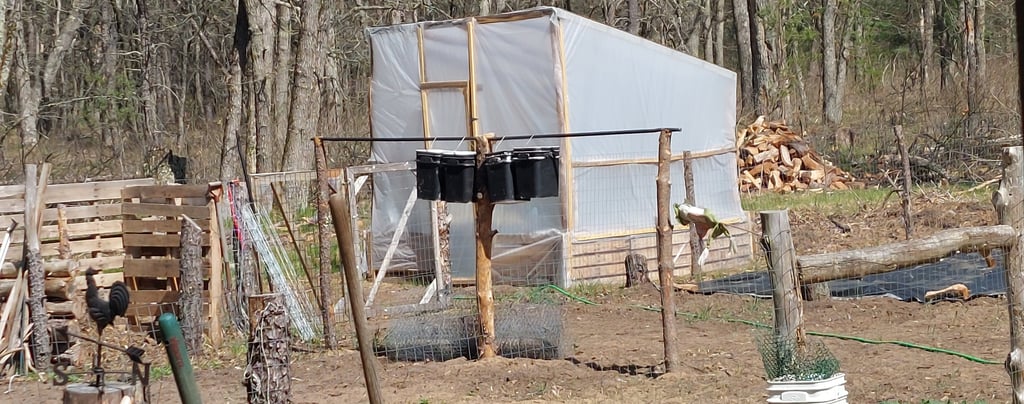How to Prepare a Garden for Winter
As the air turns crisp and the first hint of frost creeps into the early mornings, it’s a sure sign that winter is just around the corner. And while it might be tempting to abandon your garden for the cozy comforts of hot cocoa and warm blankets, there’s still some work to be done.
GARDENING


As the air turns crisp and the first hint of frost creeps into the early mornings, it’s a sure sign that winter is just around the corner. And while it might be tempting to abandon your garden for the cozy comforts of hot cocoa and warm blankets, there’s still some work to be done. But don’t worry—it’s nothing too strenuous! In fact, preparing your garden for winter can be a calm, almost meditative process. Think of it as tucking your plants in for a long winter’s nap, ensuring that when spring rolls around, everything is ready to burst back into life.
The first step in preparing your garden for winter is cleaning up. Yes, it’s kind of like cleaning your room, but instead of clothes on the floor, it’s dead plants, weeds, and debris. Take a look around your garden and start by removing anything that’s past its prime. Those once-beautiful tomato plants? They’re probably looking a bit sad now, so go ahead and pull them up. It might feel like you’re saying goodbye to an old friend, but clearing out the old growth will give your soil a fresh start for next year. Plus, pests love to hang out in old, decaying plant material, so by cleaning up, you’re giving them an eviction notice.
Now that you’ve tidied up, let’s talk about the soil. Your garden’s soil has been working hard all year, so it deserves a little TLC before winter arrives. One of the best ways to give your soil a boost is by adding compost. Think of it as a nutrient-rich snack for your plants, a little something to hold them over until spring. Spread a thick layer of compost over your garden beds—about 2 to 4 inches should do the trick. Not only will this nourish the soil, but it will also help protect it from the harsh winter weather. If you don’t have compost on hand, you can always use well-rotted manure or leaf mold.
And speaking of leaves, don’t just rake them up and toss them away! Fallen leaves are like gold for gardeners. You can shred them up and use them as mulch to protect your garden beds. Not only do they insulate the soil, but as they break down, they’ll add even more nutrients to the earth. It’s like giving your garden a cozy blanket to snuggle under during the cold months.
Next on the list: mulch. If you’ve ever thought about mulching, fall is the perfect time to do it. Mulch helps regulate soil temperature, keeps weeds at bay, and retains moisture in the soil. A layer of mulch—about 3 inches thick—spread over your garden beds will protect plant roots and help prevent soil erosion. Straw, wood chips, or even pine needles work great as mulch. Just remember to keep the mulch a few inches away from the base of your plants to prevent any mold or rot from setting in.
If you’ve got any perennials in your garden, they’ll need a little extra care to get through the winter. Trim back any dead or dying foliage, but leave about 6 inches of stem above ground to protect the plant’s crown. This will give your perennials a head start when the weather warms up again. You can also mound some mulch around the base of your perennials to insulate them against the cold. It’s like giving them a winter coat to wear.
Speaking of coats, let’s talk about your garden’s more tender plants—those that don’t handle the cold so well. For plants that aren’t winter-hardy, you can either bring them indoors or cover them with a frost blanket. Frost blankets are like magic; they keep your plants warm and protected while still allowing light and water to pass through. If you don’t have a frost blanket, an old bedsheet or burlap sack can work just as well in a pinch.
Now, let’s move on to one of my favorite parts of preparing a garden for winter: planting cover crops. I know, I know, planting something right before winter seems counterintuitive, but hear me out. Cover crops like rye, clover, or winter wheat protect your soil from erosion, suppress weeds, and add organic matter when you till them under in the spring. Plus, they just look pretty, giving your garden a bit of life during the colder months.
Winter can be rough on your garden tools, so take a little time to clean and store them properly before the snow flies. Scrub off any dirt, sharpen your pruners, and give metal parts a good wipe-down with oil to prevent rust. Then store everything in a dry place, like a shed or garage. Not only will this prolong the life of your tools, but it’ll also make your spring gardening efforts so much easier when you’ve got clean, sharp tools ready to go.
If you’ve got a greenhouse or cold frame, now’s the time to put it to good use. A cold frame is like a mini greenhouse for your garden, trapping heat and extending your growing season. You can use it to protect cool-season crops like lettuce, spinach, and kale, keeping them growing even as temperatures drop. Imagine harvesting fresh greens from your garden in the middle of winter—it’s possible with a little bit of planning and a cold frame!
For gardeners with raised beds, preparing them for winter follows much of the same process. Clear out any dead plants, add a layer of compost, and top it off with mulch. Raised beds tend to drain better than traditional garden beds, which can be a blessing in the winter when too much water can freeze and damage plant roots. But just to be safe, check that your raised beds have good drainage and aren’t collecting pools of water.
And don’t forget your containers! Potted plants need a little extra love during the winter months. If you’ve got containers that are frost-sensitive, bring them inside or place them in a sheltered spot. If they’re too big to move, wrap them in bubble wrap or an old blanket to insulate them from the cold. Your plants will thank you, and you’ll feel pretty clever for repurposing that old blanket you’ve been meaning to donate.
Now, I get it—talking about winter can feel a little gloomy. But think of it this way: preparing your garden for winter is like hitting the reset button. It gives you a chance to reflect on what worked (and what didn’t) this year, and it sets the stage for an even more successful garden next season. Plus, there’s something deeply satisfying about knowing that you’ve done everything you can to protect your plants and soil. And when spring rolls around, you’ll be more than ready to dive back into gardening with a fresh start.
So, as you pull on your wool socks and get ready to hunker down for winter, take a moment to look out over your garden. It might seem quiet now, but underneath the surface, life is still happening. Roots are growing, soil is regenerating, and your plants are simply waiting for their cue to spring back to life. Winter may seem like the end, but really, it’s just the beginning of the next chapter in your garden’s story.
And who knows? Maybe this winter, as the snow blankets your garden and the wind whistles through the trees, you’ll find yourself daydreaming about next year’s garden—what you’ll plant, how you’ll arrange your beds, and all the possibilities that lie ahead. Gardening, after all, is a year-round journey, even when the ground is covered in snow.
As always, resources like the Farmer’s Almanac or your local garden center can be incredibly helpful when it comes to specific tips and tricks for your region. So, don’t hesitate to do a little research or ask fellow gardeners for their winter prep secrets. You might be surprised at how much you can learn—and how much fun it can be to prepare your garden for winter.


Support@rusticrootshomestead.com
© 2024 Rustic Roots Homestead - All rights reserved.
